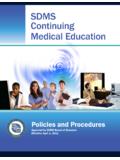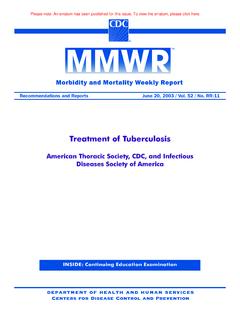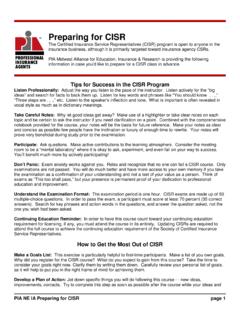Transcription of WHO Europe Critical care nursing curriculum
1 WHO Europe Critical care nursing curriculum WHO European Strategy for continuing education for Nurses and Midwives 2003 Keywords education , nursing , continuing STRATEGIC PLANNING Critical care education curriculum Europe Address requests about publications of the WHO Regional Office to: by e-mail (for copies of publications) (for permission to reproduce them) (for permission to translate them) by post Publications WHO Regional Office for Europe Scherfigsvej 8 DK-2100 Copenhagen , Denmark World Health Organization 2003 All rights reserved.
2 The Regional Office for Europe of the World Health Organization welcomes requests for permission to reproduce or translate its publications, in part or in full. The designations employed and the presentation of the material in this publication do not imply the expression of any opinion whatsoever on the part of the World Health Organization concerning the legal status of any country, territory, city or area or of its authorities, or concerning the delimitation of its frontiers or boundaries. Where the designation country or area appears in the headings of tables, it covers countries, territories, cities, or areas.
3 Dotted lines on maps represent approximate border lines for which there may not yet be full agreement. The mention of specific companies or of certain manufacturers products does not imply that they are endorsed or recommended by the World Health Organization in preference to others of a similar nature that are not mentioned. Errors and omissions excepted, the names of proprietary products are distinguished by initial capital letters. The World Health Organization does not warrant that the information contained in this publication is complete and correct and shall not be liable for any damages incurred as a result of its use.
4 The views expressed by authors or editors do not necessarily represent the decisions or the stated policy of the World Health Organization. CONTENTS Page Introduction ..1 Context ..1 The need for a continuing education Strategy ..1 The aim and purpose of the continuing education Strategy ..2 Background to the continuing education The Health care context ..4 The Critical care nursing curriculum ..6 1. Critical care nursing ..6 Definition of the Critical care 2. The Critical care nursing Aims ..6 Structure, length and mode of Entry requirements.
5 7 Competencies or learning outcomes ..7 curriculum Content ..8 Teaching/learning and assessment Supervision of practice ..10 Optimum student intake and teacher/student ratio ..10 Accreditation with ECTS Quality control and evaluation ..11 3. Teachers and 4. Location of the 5. Qualification on successful completion of the 6. Course content Modules One to Seven ..12 MODULE ONE ..14 MODULE TWO ..16 MODULE MODULE FOUR ..21 MODULE MODULE SIX.
6 26 MODULE References ..31 Acknowledgements ..37 EUR/03/5043918d page 1 Introduction This Critical care nursing curriculum has been prepared for WHO Europe as one of several post-qualifying curricula, requested by some Member States, to assist them in their progress towards implementation of the WHO European Region continuing education Strategy for Nurses and Midwives (WHO 2003). The Critical care nursing curriculum document therefore commences with a description of the context for the continuing education Strategy. Context The WHO European Region continuing education Strategy for Nurses and Midwives is set firmly within the context of the Second WHO Ministerial Conference on nursing and Midwifery in Europe , which addressed the unique roles and contributions of Europe s nurses and midwives in health development and health service delivery (WHO 2001).
7 At that Conference of Ministers of Health of Member States in the European Region, the Munich Declaration Nurses and Midwives: A Force for Health (WHO 2000a) was signed, and this key document, together with the WHO European Strategy for nursing and Midwifery education (WHO 2000) form the context for the continuing education Strategy. The need for a continuing education Strategy Nurses and midwives together constitute the largest proportion of the health care workforce in all Member States of the WHO European Region, numbering approximately six million at the start of this new century.
8 The service they provide covers 24 hours of every day of the year. It is imperative that they are competent to provide the highest quality of nursing and/or of midwifery care . In order to do this, their initial nursing and midwifery education must be such that the people of their nation can be assured of their competence to practise on entry to their professions of nursing and midwifery, and that the foundation has been laid for them to continue to learn throughout their professional lives. Maintenance and further development of competence is essential to the ongoing provision of high quality nursing and midwifery care .
9 In the rapidly changing health care services of today, with the knowledge explosion and the impact of technology upon health care , many nurses and midwives are increasingly called upon to work in expanded, specialist and/or advanced practice roles. The WHO European Strategy for continuing education for nurses and midwives has been developed in order to assist Member States to ensure the continuing competence of their nursing and midwifery workforce. In some cases this will be by developing new knowledge for specialist fields of clinical nursing and midwifery practice, in others by deepening their knowledge of an existing field of practice, and in yet others by gaining new competencies in the field of nursing and/or midwifery education , management or research.
10 The continuing education Strategy does not stand alone. Firstly, it builds upon the firm foundation provided by the WHO European Strategy for nursing and Midwifery education (WHO 2000), in which the link between initial and continuing education is clearly stated: The initial programme of education must prepare nurses and midwives who are not only competent to practise in today's health services, but who value and are committed to maintaining that competence. This they will achieve through continuing to update their knowledge, skills and EUR/03/5043918d page 2 attitudes, in order that they can continue to meet the changing health priorities and needs of the people of the Member States (WHO 2000).













